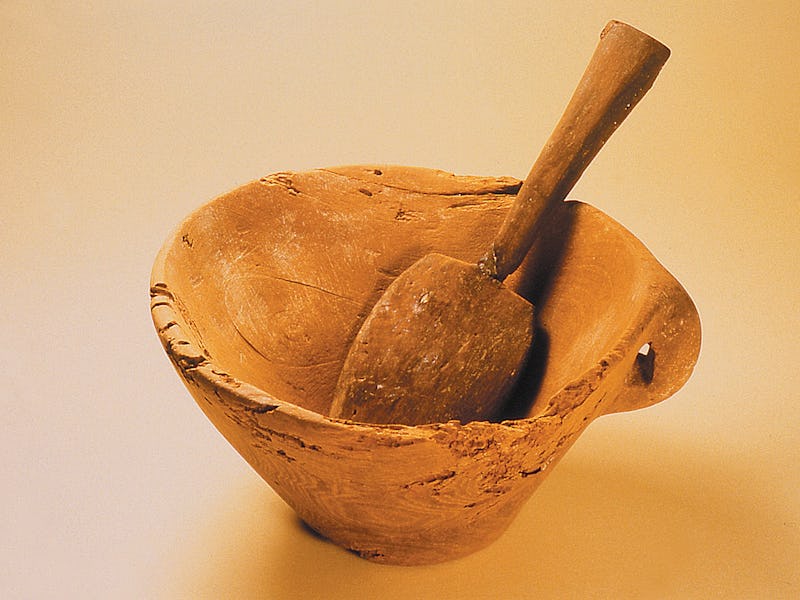Archaeologists Uncover First Direct Evidence of Drug Use From the Bronze Age
Humanity’s drug use is globally pervasive and incalculably old.

Drugs — whether psychedelics or otherwise — are experiencing a bit of a renaissance.
Gone are the decades when LSD, marijuana, or magic mushrooms carried a heavy and often criminalized stigma. Psilocybin, the active ingredient in magic mushrooms, is now being used to alleviate major depression, as well as alcohol use disorder, and midomafetamine (MDMA) is being considered a potential treatment for PTSD.
But if we dip back in human history long before psychedelics and other stimulants got their infamous bad rep, it seems our ancestors had no qualms about getting lit on a Friday night (or maybe a Tuesday afternoon).
Whether in South America, where some ancient civilizations used psychedelic plants before ritual human sacrifice, or opium in ancient Greece for healing and channeling the divine, humanity’s drug use was globally pervasive and incalculably old.
But there’s been one problem: Finding direct evidence connecting our blissed-out forebears with their abandoned paraphernalia or drug-inspired rock art. For that, the best evidence is human remains, some of which archaeologists have largely uncovered from ancient hair and bone samples of mummies.
In a paper published Thursday in the journal Scientific Reports, archaeologists have found more direct evidence of ancient drug use — arguably the first for Europe — from a prehistoric cave in Menorca, one of the Balearic Islands off of eastern Spain. Hair strands recovered from this cave (known as Cova d’es Càrritx) dating back 3,000 years ago tested positive for a whole slew of plant-derived compounds, specifically atropine, scopolamine, and ephedrine. Given where and how the hair was stashed and the amounts of chemicals contained, the researchers believe the plants were used as a part of a ritual ceremony overseen by a shaman, in line with other archaeological finds pointing to drug use as entwined with ancient spiritual traditions and practices.
The inner chamber of Cova d’es Càrritx cave.
A cave dating back to the Bronze Age
Cova d’es Càrritx was first excavated in March 1995 by archaeologists in the U.K. and Spain and discovered to hold not one but seven connected chambers that branch like a single trunk burrowing into the interior of the Algendar Canyon, a rocky landscape that’s considered to be one of the most important of the Late Bronze Age — so about 3,300 years ago — on Menorca.
Judging from the artifacts excavated, the cave served as a sort of mortuary around 3,600 years ago, chamber one being the main funerary space. Archaeologists believe while the dead were being prepared in this chamber, a piece of hair was cut, sometimes dyed red with plant extracts, and then placed in tubular containers made of wood or antler. These containers would remain with the dead but at some point in the cave’s history, select containers of hair were being put for safekeeping within the mid-section of Cova d’es Càrritx in chamber five.
In the new paper, archaeologists led by Elisa Guerra-Doce, an associate professor of prehistory at the University of Valladolid in Spain, who’s previously done research in the use of psychoactive substances in prehistoric Eurasia, unearthed 10 of these containers but only did a toxicology study of the reddish, five-inch long hairs nestled inside one container. (Whenever someone ingests or is exposed to a substance in their immediate environment, the chemical compounds tend to get incorporated into hair cells on the scalp and body and into strands of hair themselves.)
Close-up of hair strands retrieved from containers in Cova d’es Càrritx.
Guerra-Doce and her team found that the hairs, dating back 3,000 years ago, contained atropine, a chemical belonging to a class of drugs known as anticholinergics, often used to dilate the pupil before eye exams. Toxicology results also came back positive for scopolamine, a drug that we now use to treat nausea and vomiting caused by motion sickness or from the surgical anesthetic, and in a drug that’s long been found in many diet pills and sports supplements (but since banned in the US), ephedrine.
Drug use was likely associated with medicinal and maybe spiritual practices
But where did these potent chemicals come from, and why were our ancient ancestors using them? To answer the latter, researchers surmise they were used for medicinal purposes and maybe for spiritual ones as well.
Atropine and scopolamine can both be found in plants and vegetables belonging to the nightshade family Solanaceae, the same family as potatoes, eggplants, and tomatoes. There are plenty of nightshade plants on Menorca, such as mandrake, henbane, and thorn apple (also known as jimsonweed). Various parts of these plants have been used medicinally; mandrake has been used as a sedative and painkiller for over 2,000 years.
In the Mediterranean, ephedrine can be found in plants like joint pine, a poisonous shrub that’s been highly prized for its medicinal and stimulant properties (it can increase alertness and physical activity) since antiquity.
Dyeing scene in the funerary chamber.
It’s hard to say when exactly the individual who the hair belongs started partaking in any of these plants, but it was probably over a period of a year or longer and right up until this person’s death.
Since this hair was stored in a container farther down from the main chamber and was covered in an interesting pattern of concentric circles surrounding a single dot (the researchers say this pattern could be interpreted as dilated pupils under the influence), this individual might have held some special importance in ancient Menorcan society, perhaps a shaman. The researchers speculate that this container made of olive tree wood was probably placed in the deeper chamber by individuals who sought to preserve their ancient traditions as society evolved and modernized.
This article was originally published on